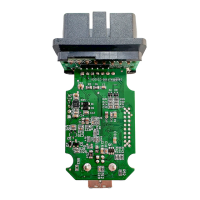Ethernet (ETH): media access control (MAC) with DMA controller RM0090
1138/1749 RM0090 Rev 18
There are two modes of operation for popping data towards the MAC core:
• In Threshold mode, as soon as the number of bytes in the FIFO crosses the configured
threshold level (or when the end-of-frame is written before the threshold is crossed),
the data is ready to be popped out and forwarded to the MAC core. The threshold level
is configured using the TTC bits of ETH_DMABMR.
• In Store-and-forward mode, only after a complete frame is stored in the FIFO, the frame
is popped towards the MAC core. If the Tx FIFO size is smaller than the Ethernet frame
to be transmitted, then the frame is popped towards the MAC core when the Tx FIFO
becomes almost full.
The application can flush the Transmit FIFO of all contents by setting the FTF
(ETH_DMAOMR register [20]) bit. This bit is self-clearing and initializes the FIFO pointers to
the default state. If the FTF bit is set during a frame transfer to the MAC core, then transfer
is stopped as the FIFO is considered to be empty. Hence an underflow event occurs at the
MAC transmitter and the corresponding Status word is forwarded to the DMA.
Automatic CRC and pad generation
When the number of bytes received from the application falls below 60 (DA+SA+LT+Data),
zeros are appended to the transmitting frame to make the data length exactly 46 bytes to
meet the minimum data field requirement of IEEE 802.3. The MAC can be programmed not
to append any padding. The cyclic redundancy check (CRC) for the frame check sequence
(FCS) field is calculated and appended to the data being transmitted. When the MAC is
programmed to not append the CRC value to the end of Ethernet frames, the computed
CRC is not transmitted. An exception to this rule is that when the MAC is programmed to
append pads for frames (DA+SA+LT+Data) less than 60 bytes, CRC will be appended at the
end of the padded frames.
The CRC generator calculates the 32-bit CRC for the FCS field of the Ethernet frame. The
encoding is defined by the following polynomial.
Transmit protocol
The MAC controls the operation of Ethernet frame transmission. It performs the following
functions to meet the IEEE 802.3/802.3z specifications. It:
• generates the preamble and SFD
• generates the jam pattern in Half-duplex mode
• controls the Jabber timeout
• controls the flow for Half-duplex mode (back pressure)
• generates the transmit frame status
• contains time stamp snapshot logic in accordance with IEEE 1588
When a new frame transmission is requested, the MAC sends out the preamble and SFD,
followed by the data. The preamble is defined as 7 bytes of 0b10101010 pattern, and the
SFD is defined as 1 byte of 0b10101011 pattern. The collision window is defined as 1 slot
time (512 bit times for 10/100 Mbit/s Ethernet). The jam pattern generation is applicable only
to Half-duplex mode, not to Full-duplex mode.
In MII mode, if a collision occurs at any time from the beginning of the frame to the end of
the CRC field, the MAC sends a 32-bit jam pattern of 0x5555 5555 on the MII to inform all
Gx() x
32
x
26
x
23
x
22
x
16
x
12
x
11
x
10
x
8
x
7
x
5
x
4
x
2
x1+ + + + + + + +++++++=

